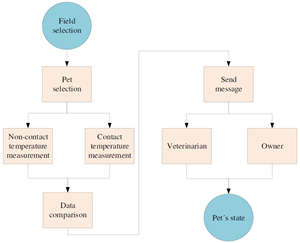Development of Non-Contact Real-Time Monitoring System for Animal Body Temperature
DOI:
https://doi.org/10.46604/peti.2022.8870Keywords:
animal body temperature sensing, Internet of things, image detection, infrared thermographyAbstract
Body temperature is an important indicator of health monitoring. However, since animals are covered with fur, it is difficult to obtain their accurate body temperature with the traditional infrared measurement technology. To deal with this problem, this research proposes a non-contact real-time monitoring system using an infrared method combined with object detection. The system is developed based on general infrared thermal imaging technology and an infrared thermal imaging module with an image tracking algorithm. YOLO is used to detect animals, and a thermal imaging camera is used to measure the body surface temperature of animals. The result shows that the proposed system can accurately measure the body temperature of animals without being influenced by animals’ fur. In the future, it can be applied to monitor the body temperature of sick animals in veterinary hospitals.
References
J. L. Hatfield, “Measuring Plant Stress with an Infrared Thermometer,” HortScience, vol. 25, no. 12, pp. 1535-1538, December 1990.
E. J. Sadler, C. R. Camp, D. E. Evans, and J. A. Millen, “Corn Canopy Temperatures Measured with a Moving Infrared Thermometer Array,” Transactions of the American Society of Agricultural Engineers, vol. 45, no. 3, pp. 581-591, 2002.
T. Matsukawa, M. Ozaki, T. Nishiyama, M. Imamura, and T. Kumazawa, “Comparison of Infrared Thermometer with Thermocouple for Monitoring Skin Temperature,” Critical Care Medicine, vol. 28, no. 2, pp. 532-536, February 2000.
S. Abbasbandy, “Homotopy Analysis Method for Heat Radiation Equations,” International Communications in Heat and Mass Transfer, vol. 34, no. 3, pp. 380-387, March 2007.
C. A. Balaras and A. A. Argiriou, “Infrared Thermography for Building Diagnostics,” Energy and Buildings, vol. 34, no. 2, pp. 171-183, February 2002.
B. B. Lahiri, S. Bagavathiappan, T. Jayakumar, and J. Philip, “Medical Applications of Infrared Thermography: A Review,” Infrared Physics and Technology, vol. 55, no. 4, pp. 221-235, July 2012.
S. Bagavathiappan, B. B. Lahiri, T. Saravanan, J. Philip, and T. Jayakumar, “Infrared Thermography for Condition Monitoring—A Review,” Infrared Physics and Technology, vol. 60, pp. 35-55, September 2013.
L. S. Peck, M. S. Clark, S. A. Morley, A. Massey, and H. Rossetti, “Animal Temperature Limits and Ecological Relevance: Effects of Size, Activity, and Rates of Change,” Functional Ecology, vol. 23, no. 2, pp. 248-256, March 2009.
D. M. Newsom, G. L. Bolgos, L. Colby, and J. A. Nemzek, “Comparison of Body Surface Temperature Measurement and Conventional Methods for Measuring Temperature in the Mouse,” Journal of the American Association for Laboratory Animal Science, vol. 43, no. 5, pp. 13-18, September 2004.
G. J. Tattersall and V. Cadena, “Insights into Animal Temperature Adaptations Revealed through Thermal Imaging,” The Imaging Science Journal, vol. 58, no. 5, pp. 261-268, July 2010.
P. A. Warn, M. W. Brampton, A. Sharp, G. Morrissey, N. Steel, D. W. Denning, et al., “Infrared Body Temperature Measurement of Mice as an Early Predictor of Death in Experimental Fungal Infections,” Laboratory Animals, vol. 37, no. 2, pp. 126-131, April 2003.
N. A. Othman and I. Aydin, “A New Deep Learning Application Based on Movidius NCS for Embedded Object Detection and Recognition,” 2nd International Symposium on Multidisciplinary Studies and Innovative Technologies, pp. 1-5, October 2018.
T. H. Chung, W. S. Jung, E. H. Nam, J. H. Kim, S. H. Park, and C. Y. Hwang, “Comparison of Rectal and Infrared Thermometry for Obtaining Body Temperature of Gnotobiotic Piglets in Conventional Portable Germ Free Facility,” Asian-Australasian Journal of Animal Sciences, vol. 23, no. 10, pp. 1364-1368, October 2010.
J. C. Cuevas and F. J. García-Vidal, “Radiative Heat Transfer,” ACS Photonics, vol. 5, no. 10, pp. 3896-3915, September 2018.
J. K. Baird and T. R. King, “A Wien Displacement Law for Impact Radiation,” International Journal of Impact Engineering, vol. 23, no. 1, pp. 39-49, December 1999.
W. Shi, J. Cao, Q. Zhang, Y. Li, and L. Xu, “Edge Computing: Vision and Challenges,” IEEE Internet of Things Journal, vol. 3, no. 5, pp. 637-646, October 2016.
G. Montambaux, “Generalized Stefan-Boltzmann Law,” Foundations of Physics, vol. 48, no. 4, pp. 395-410, March 2018.
Q. Zhu, H. Zheng, Y. Wang, Y. Cao, and S. Guo, “Study on the Evaluation Method of Sound Phase Cloud Maps Based on an Improved YOLOv4 Algorithm,” Sensors, vol. 20, no. 15, Article no. 4314, August 2020.
J. M. Zurada, Introduction to Artificial Neural Systems, Saint Paul: West Publishing, 1992.
A. Bochkovskiy, C. Y. Wang, and H. Y. M. Liao, “Yolov4: Optimal Speed and Accuracy of Object Detection,” https://arxiv.org/pdf/2004.10934v1.pdf, April 23, 2020.

Published
How to Cite
Issue
Section
License
Submission of a manuscript implies: that the work described has not been published before that it is not under consideration for publication elsewhere; that if and when the manuscript is accepted for publication. Authors can retain copyright of their article with no restrictions. Also, author can post the final, peer-reviewed manuscript version (postprint) to any repository or website.

Since Oct. 01, 2015, PETI will publish new articles with Creative Commons Attribution Non-Commercial License, under The Creative Commons Attribution Non-Commercial 4.0 International (CC BY-NC 4.0) License.
The Creative Commons Attribution Non-Commercial (CC-BY-NC) License permits use, distribution and reproduction in any medium, provided the original work is properly cited and is not used for commercial purposes







